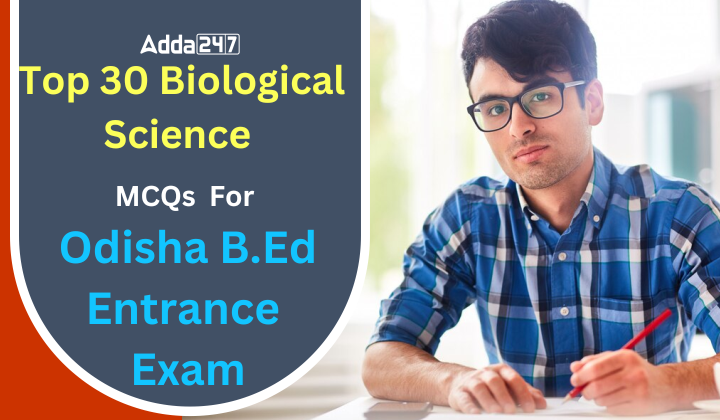Preparing for the Odisha B.Ed Entrance Exam in Biological Sciences requires a solid understanding of key concepts. The top 30 MCQs typically cover a range of topics including cell biology, genetics, evolution, ecology, and human physiology. These questions are designed to test both fundamental knowledge and application skills. For instance, you might encounter questions on the structure and function of cell organelles, Mendelian genetics, Darwinian theory, ecological interactions, and the human circulatory system. Mastering these areas through targeted MCQ practice can enhance your exam readiness and boost your confidence in tackling complex biological concepts.
Top 30 Biological Science MCQs For Odisha B.Ed Entrance Exam
- Q: Who first discovered cells?
A) Robert Hooke
B) Anton Van Leeuwenhoek
C) Matthias Schleiden
D) Theodor Schwann
Answer: A) Robert Hooke - Q: What is the fluid present inside the cell membrane called?
A) Cytoplasm
B) Nucleoplasm
C) Protoplasm
D) Matrix
Answer: A) Cytoplasm - Q: Which organelle is known as the powerhouse of the cell?
A) Nucleus
B) Endoplasmic Reticulum
C) Golgi Apparatus
D) Mitochondria
Answer: D) Mitochondria - Q: Which cell organelle is responsible for protein synthesis?
A) Ribosome
B) Mitochondria
C) Lysosome
D) Chloroplast
Answer: A) Ribosome - Q: What structure provides rigidity and support to plant cells?
A) Cell Membrane
B) Cell Wall
C) Cytoskeleton
D) Vacuole
Answer: B) Cell Wall - Q: Which of the following is present only in plant cells?
A) Chloroplast
B) Mitochondria
C) Ribosome
D) Lysosome
Answer: A) Chloroplast - Q: What is the function of lysosomes in the cell?
A) Protein synthesis
B) Energy production
C) Digestion of waste materials
D) Photosynthesis
Answer: C) Digestion of waste materials - Q: Which of the following cell organelles is involved in the synthesis of lipids and steroids?
A) Rough Endoplasmic Reticulum
B) Smooth Endoplasmic Reticulum
C) Golgi Apparatus
D) Ribosome
Answer: B) Smooth Endoplasmic Reticulum - Q: What is the main function of the Golgi apparatus?
A) Synthesizing proteins
B) Modifying, sorting, and packaging proteins
C) Breaking down cellular waste
D) Providing energy to the cell
Answer: B) Modifying, sorting, and packaging proteins - Q: What is the function of the nucleolus?
A) Synthesizing lipids
B) Synthesizing ribosomes
C) Producing ATP
D) Packaging proteins
Answer: B) Synthesizing ribosomes - Q: Which type of cell lacks a true nucleus?
A) Eukaryotic cell
B) Prokaryotic cell
C) Animal cell
D) Plant cell
Answer: B) Prokaryotic cell - Q: Which component of the cell membrane allows it to be selectively permeable?
A) Phospholipid bilayer
B) Cholesterol molecules
C) Membrane proteins
D) Carbohydrate chains
Answer: C) Membrane proteins - Q: What is the function of the plasma membrane?
A) Protein synthesis
B) Controlling the movement of substances in and out of the cell
C) Energy production
D) Digesting cellular waste
Answer: B) Controlling the movement of substances in and out of the cell - Q: What is the primary role of the nucleus?
A) Energy production
B) Protein synthesis
C) Storing genetic information
D) Transporting materials
Answer: C) Storing genetic information - Q: What is the name of the process by which cells produce energy in the form of ATP?
A) Photosynthesis
B) Glycolysis
C) Cellular respiration
D) Fermentation
Answer: C) Cellular respiration - Q: Which organelle is known as the ‘cell’s post office’ for its role in packaging and transporting proteins?
A) Ribosome
B) Golgi apparatus
C) Endoplasmic reticulum
D) Lysosome
Answer: B) Golgi apparatus - Who coined the term “Ecosystem”?
A) Charles Darwin
B) Gregor Mendel
C) A.G. Tansley
D) Robert Hooke
Answer: C) A.G. Tansley - What are the two main components of an ecosystem?
A) Plants and animals
B) Producers and consumers
C) Biotic and abiotic components
D) Air and water
Answer: C) Biotic and abiotic components - Which of the following is a biotic component of an ecosystem?
A) Water
B) Soil
C) Plants
D) Temperature
Answer: C) Plants - Which of the following is an abiotic component of an ecosystem?
A) Animals
B) Microorganisms
C) Minerals
D) Decomposers
Answer: C) Minerals - Which organisms are considered primary producers in an ecosystem?
A) Herbivores
B) Carnivores
C) Plants
D) Decomposers
Answer: C) Plants - What do primary consumers primarily feed on?
A) Other consumers
B) Decomposers
C) Producers
D) Carnivores
Answer: C) Producers - Which of the following is an example of a secondary consumer?
A) Grass
B) Rabbit
C) Lion
D) Fungi
Answer: C) Lion - Which term describes organisms that break down dead organic material?
A) Producers
B) Consumers
C) Decomposers
D) Carnivores
Answer: C) Decomposers - In which type of ecosystem would you find the tundra?
A) Desert
B) Aquatic
C) Forest
D) Terrestrial
Answer: D) Terrestrial - Which ecosystem is characterized by high biodiversity and large salt content?
A) Freshwater ecosystem
B) Desert ecosystem
C) Marine ecosystem
D) Grassland ecosystem
Answer: C) Marine ecosystem - What is the primary role of decomposers in an ecosystem?
A) Produce food
B) Consume other organisms
C) Break down dead matter
D) Provide shelter
Answer: C) Break down dead matter - Which of the following is a characteristic of a desert ecosystem?
A) High rainfall
B) Dense vegetation
C) Scarce vegetation and low rainfall
D) Cold climate year-round
Answer: C) Scarce vegetation and low rainfall - What is nutrient cycling in an ecosystem?
A) The process of producing food
B) The flow of energy from one organism to another
C) The consumption and recycling of nutrients
D) The decomposition of organic matter
Answer: C) The consumption and recycling of nutrients - Which type of ecosystem would a savanna grassland be classified as?
A) Marine ecosystem
B) Freshwater ecosystem
C) Terrestrial ecosystem
D) Desert ecosystem
Answer: C) Terrestrial ecosystem









